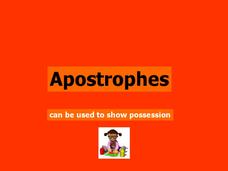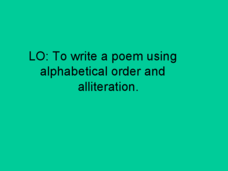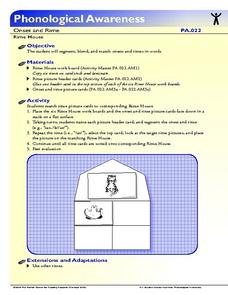Curated OER
Apostrophes
Here is some very good, interactive practice for your class regarding when they should, and should not, use apostrophes. Clear examples are given, and learners have ample opportunities to practice the skill. Instant feedback is given for...
Curated OER
Homonyms
Nineteen sets of homonyms are listed in this colorful PowerPoint. Each set is on its own slide with accompanying images to help understanding. This is a fabulous presentation to show during your homonyms lesson!
Curated OER
The Nine Parts of Speech
Use this helpful resource to review the parts of speech. This is a motivating and interesting way to discuss nouns, adjectives, pronouns, verbs, adverbs, prepositions, conjunctions, articles, and interjections. This could be used in a...
Curated OER
Writing Review
This presentation provides a series of activities that can be used as morning warm ups throughout the week, or as a writing review. Learners put words in ABC order, learn about alliteration, correct punctuation in a series of sentences,...
Curated OER
Complete Sentences
Looking for a good presentation on complete sentences, subject, and predicate? This one's for you! Learners are coached regarding what a sentence needs to be complete. After some teacher-guided practice, pupils must find the sentence...
Curated OER
Complete Sentences
Being able to distinguish between a complete sentence and an incomplete sentence is an important skill, one set as a standard by the Common Core initiative. This presentation does a shows viewers what it takes to make a complete...
Curated OER
Spellcheck Outlaws
These outlaws are hard to catch! Spellcheckers do not notice certain grammatical mistakes when they are technically correctly spelled words. For instance, one does not want to say that the colors compliment each other on the slide since...
Curated OER
The Coachella Festival
A New York Time article on a major music and arts event can be a good way to get kids interested in the daily news. They read an article about Coachella, and then answer eight comprehension questions, in either blog or print form. Note:...
Curated OER
Student Opinion: What Small Things Have You Seen and Taken Note of Today?
An interesting and unusual topic for a news article, this resource from the New York Times website asks learners to take a moment and consider all the things they notice during a typical day. Based of the editorial piece "Things I Saw"...
Curated OER
Do You Prefer Your Children's Book Characters Obedient or Contrary? Opinion Writing
With this New York Times "Learning Network" exercise, high schoolers read an article about the death of Maurice Sendak, author of Where the Wild Things Are and then respond to several prompts that require them to shape their own opinions...
Curated OER
Student Opinion: What Are You Afraid Of?
A great resource for informational texts as well as writing topics, the New York Times website provides writing prompts about various news articles through The Learning Network. This particular activity provides a very short reading...
K12 Reader
An Adverb Can Tell Where
Outside, backwards, far. Adverbs that tell where action is happening is the focus of a colorful one-page worksheet that asks kids to select the appropriate adverb from the provided word bank.
K12 Reader
Comparative & Superlative Practice II
Grammar practice gets good, better, and best! Choose when to use comparative and superlative forms of various adverbs in 12 sentences. Examples at the top of the page guide kids to select the best form based on how many people or items...
K12 Reader
Punctuating Appositives
Where do the commas go? Kids rewrite a series of sentences using commas to set off the appositives in each sentence.
K12 Reader
Appositives at the Beginning or End
Identifying the appositives that are found at the beginning or the end of sentences is the focus of this activity.
K12 Reader
Object Pronouns Worksheet Two
Here is some basic practice with object pronouns. Learners find the object pronouns in each sentence and circle them. A brief definition of object pronouns and a list of object pronouns are provided at the top of the page.
K12 Reader
Simplify with Pronouns Worksheet Two
Use nursery rhymes to help teach pronouns. Learners read the familiar sentences and replace the repeated words with the proper pronouns. Prior knowledge of these phrases helps to scaffold the exercise.
K12 Reader
Identify the Antonym
What happens to a sentence when you replace a word with its antonym? A two-part instructional activity asks learners to select words opposite in meaning to provided words, and then to craft sentences using antonyms for given words.
Curated OER
Tu o Usted? Explanation and Worksheet 1
What is the difference between using tú or usted? This activity provides a thorough, clear explanation, and there's an opportunity to practice. The exercise lists different people and asks the learner to identify whether the informal or...
Curated OER
Possessive Adjectives
This activity contains clear information on possessive adjectives. After explaining what a possessive adjective is in English, there's a chart for learners to complete to identify the Spanish equivalent of words like my, your, his, etc....
Curated OER
Jazzing Up the Classroom
Tune-up mundane subjects with some lively jazz for a cross-currricular kick!
Florida Center for Reading Research
Phonics: Letter-Sound Correspondence, Letter-Sound Match
Boost initial, medial, and final sound correspondence. Scholars practice decomposing word sounds using image cards and a worksheet. Learners cut out 10 three-letter images, sound them out, and glue them on the worksheet. Each word is...
Florida Center for Reading Research
Phonological Awareness: Rhyme, Rhyme or No Rhyme
Rhyming is fun, builds phonemic awareness, and is a tried and true pre-reading skill. This activity helps learners identify words that rhyme. Young scholars listen to a song, locate a rhyming word they hear by clapping then draw a...
Florida Center for Reading Research
Phonological Awareness: Onset and Rime, Rime House
Are you covering onset and rime with budding readers? Here, learners examine six "rime house" work boards, each with an image at the top. Working with a partner, they segment each top image's onset and rime. Then, they pick cards and...
Other popular searches
- No More Dead Dogs
- Dog Evolution
- Love That Dog
- Dog Sled Racing
- Compound Words Hot Dog
- Prairie Dogs
- Dogs & Cats
- Hot Dog
- Dog of Pompeii
- Dogs and Cats
- Dog Sled
- Dog Teams

























